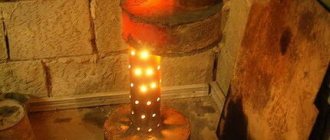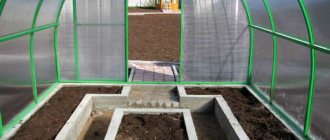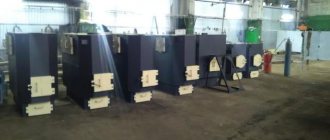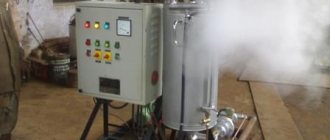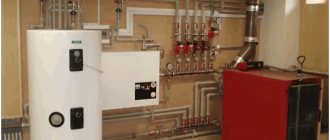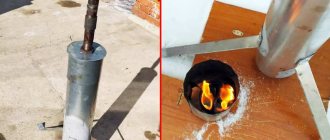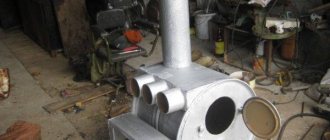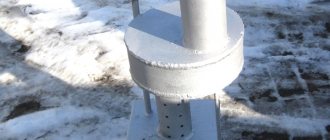Heating utility rooms, service stations, greenhouses and workshops is a pressing problem for many.
Boiler under development
It is not always possible to gasify these premises, and heating with electric appliances is very ineffective. An exhaust boiler with a water circuit is an excellent solution that allows you to use resources economically and efficiently.
In this article we will look at the principle of operation, the design of the boiler during testing and tell you how to build this unit with your own hands.
The main advantage of such a boiler is its fuel efficiency, because sometimes you can even get it for free. Many car services and workshops provide recycled oil on condition of pickup.
Device
Any boiler operating in mining is designed as follows: the burner creates a torch that heats the firebox (combustion chamber), surrounded on all sides by a water jacket. The hot gases give off heat to the water jacket, then pass through smoke pipes, also surrounded on all sides by water.
This boiler design is called two-pass or reversible, because the gases pass through the firebox in one direction, then return through the smoke pipes and go into the chimney. There are three-pass boilers that have an additional row of smoke pipes, which causes the smoke to make another turn and move to the far end of the firebox, from where it goes into the chimney.
Since waste often contains all kinds of debris and antifreeze, a filter is installed in front of the burner to clean the fuel and reduce the risk of nozzle clogging.
In addition, the firebox must have at least one cleaning door through which the slag formed as a result of oil combustion is removed and the walls of the combustion chamber are cleaned of soot.
This is especially true when the heating device is operating in low power mode, because the release of thermal energy, and therefore the heating of the walls of the firebox, is minimal, which is why not all the fuel entering it burns . Some of the fuel is only partially oxidized and soot settles on the walls of the combustion chamber.
If you do not clean the boiler of soot for a long time, then as the power increases, the temperature in the combustion chamber will increase and the soot may ignite, which will sharply heat up the walls of the furnace and lead to a jump in the temperature of the coolant until it boils.
In addition, any boiler must have means for adjusting power and controlling the torch; without this, the danger of using a heating device during testing increases tenfold.
What is good about a brick oven with a water boiler?
How can you not enjoy the sounds of peacefully crackling logs in a bathhouse?
And what if, besides, there was an original wicker firewood basket nearby, with logs lying comfortably in it? Modern wickerwork used for these purposes is made from wicker, birch bark and even metal. Woven into a trough shape, they allow firewood to be neatly stacked and beautifully complement the design of the sauna. This is not only an aesthetic pleasure, it is also “natural” warmth, heat and a unique aroma. How to save firewood, since it takes a lot of it to kindle? Every year the popularity of standard or Russian stoves with water heating boilers is growing. A brick kiln with a water circuit is characterized by good heat transfer, reliability and high efficiency. This design will be effective both in a small and in a bath room with an area of up to 100 sq.m.
It is not too difficult to make such a design, the main thing is to take into account all the features and recommendations. For example, the pipe must not only be thick-walled, but also seamless, the welding seam must match the thickness of the pipe walls, and the feed is welded only to the edge of the upper thick pipe. The oven is laid out with ordinary and refractory bricks; for masonry, ordinary and refractory mortar are used. Such bath heating will be reliable, durable and comfortable.
Pellet stoves are an economical and convenient device that allows you to save on fuel. Pellet units operate on special compressed pellets made from wood shavings, which are easily combustible. The main advantage of the work is that the pellet burner is able to burn fuel as efficiently as possible thanks to unique supply algorithms, as well as the flow of air, which helps regulate combustion.
A wood burning stove with a water circuit is efficient and reliable. Such designs make it possible to heat large rooms, even at low outside temperatures. Their advantage is an environmentally friendly combustion process and good efficiency. In the process of their work, they produce process water at high temperatures, which is also used. At the same time, fuel costs are minimal, and the heating rate of the room is fast. The stove looks like a steel firebox with a wall thickness of 4-6 mm. The heat exchanger tubes are located between the walls.
Each of the described options is a universal solution for heating a bathhouse or other country house. Having decided to purchase a stove of a certain type, you need not only to study the options for modern models offered by manufacturers, but also to think through everything thoroughly and take into account the parameters of the actual room where it will be installed, its area, and functional features.
How to determine the sufficient power of a heating device?
The power of the boiler should be several percent greater than the heat loss of the building , so the smaller it is and the better it is insulated, the less powerful the apparatus is needed to heat it.
It is generally accepted that in central Russia, for a well-insulated house, the boiler power should be 1 kW for every 10 m2 of its area.
That is, to heat a building with a total area of 155 m2, you will need a heating device capable of constantly delivering 16 kW of thermal energy .
However, to reduce the load on the heating device and increase the reliability of the entire system, we recommend increasing the power by 15–25%, that is, for a house with an area of 155 m2, a boiler with a capacity of 18–20 kW/h would be ideal.
General operating principle
If we want to get high-quality heating based on waste, we cannot simply take the oil and set it on fire, as it will smoke and stink. To avoid these unpleasant and hazardous side effects, you need to heat the fuel so that it begins to evaporate.
Volatile substances obtained as a result of heating will burn. This is the basic principle of operation of the heating unit during testing.
Application of perforated tube
To implement this principle, the design of the stove includes two chambers, which are connected to each other by a pipe with holes. Fuel enters the lower chamber through the filler hole, which is heated here. The resulting volatile substances rise up the pipe, becoming saturated with air oxygen through the perforation.
A schematic diagram of a two-chamber stove with a connecting perforated pipe allows you to understand exactly how a simple unit functions during mining
The resulting combustible mixture ignites in the chimney, and its complete combustion occurs in the upper afterburning chamber, separated from the chimney by a special partition. If the process technology is properly followed, virtually no soot or smoke is generated during combustion. But the heat will be enough to warm the room.
Using the plasma bowl
In order to achieve maximum efficiency of the process, you can go a more complicated route. Let us recall that our goal is to separate volatile components from the fuel by heating it. To do this, a metal bowl should be placed in the only chamber of the unit, which must not only be heated, but heated.
Through a special dispenser, waste will flow from the fuel tank into the chamber in a thin stream or drops. Once on the surface of the bowl, the liquid will instantly evaporate, and the resulting gas will burn.
The efficiency of this model is higher, since fuel supplied by drip burns better, and the problem of topping it up during the operation of the furnace disappears by itself
If everything is done correctly, the combustion of gases should be accompanied by a bluish-white flame. A similar flame can be observed when a plasma burns, which is why the red-hot bowl is often called a plasma bowl. And the technology itself is called drip feed: after all, fuel must be supplied in exclusively small doses.
With all the variety of designs, the operation of all heating units using waste fuel is based on the principle described above.
Where can I get the drawings?
Finding drawings of a boiler and burner for a certain power is not easy, because few people develop heating devices that operate only on waste oil; much more often they make a universal boiler with given power parameters and a burner for it.
Therefore, to search for drawings, calculations and recommendations you have to re-read various forums , including those on solid fuel heating devices, because the boiler itself works equally well with any heat source.
Often, such DIYers take some old gas or even wood-burning boiler, restore it to working condition, and then make a burner for it with certain torch parameters.
One of the most important elements of such a boiler is a controller that checks the presence of a torch and also regulates the fuel supply depending on the temperature in the house.
Therefore, we have prepared links to forums where users discuss the independent production of all parts of such heating devices.
These are the links:
- www.forumhouse.ru.
- termoportal.ru.
- fermer.ru.
- www.land-cruiser.ru.
- forum.abok.ru.
- www.rusfishing.ru.
- forums.drom.ru.
- www.chipmaker.ru.
- www.allremont.ru.
- forum.yourdom.ru.
- boatclub.ru.
- krainamaystriv.com.
- mwob.com.ua.
The principle of operation of boilers during mining
All boilers that use waste oil operate on the same principle, which is to evaporate the oil and burn its steam. However, everything is not so simple here.
The fact is that used oil is a substance that contains many additives, heavy metals and various elements. And so that when the fuel burns, they do not fly out into the chimney, it is necessary to ensure that the temperature inside the boiler for heating the house reaches 600 ° C. It is under such conditions that complete oxidation of these elements occurs.
Oil evaporation can occur in two ways:
- Casting it onto a hot container, which is called a combustion bowl.
- Igniting a liquid substance. In this case, the released steam burns out in special chambers.
Since there are only two of these methods, each owner can make a heating boiler with his own hands in two modifications. They can be seen in different videos or in many photos.
How does the burner work?
There are 2 types of burners:
- evaporators (drip);
- injectors (supercharged).
The basis of the drip burner is the evaporator bowl into which fuel slowly drips.
Part of the waste burns in the bowl, increasing the temperature there and starting the pyrolysis process, while the other part evaporates and breaks up into volatile hydrocarbons and other gases, which rise above the bowl, mix with the incoming air and burn.
The fuel supply system monitors the amount of fuel in the bowl and either opens the valve to replenish the amount of liquid, or closes it to prevent waste from overflowing.
The main advantages of the evaporator are:
- simplicity of design;
- the ability to function in training of any quality.
The injector works differently. First, the fuel is heated to make it more fluid, then it is fed under pressure through a calibrated hole into the mixer, into which air is pumped. In the mixer, waste and air are mixed, after which they exit the nozzle into the combustion zone.
The mixture can be ignited using an open fire, an electric arc or a hot metal plate. They regulate the power of the injector by changing the volume of air supply and oil pressure , so that the ratio of fuel to fuel will always be the same.
If you do not have experience in making such devices, then make an evaporator, because it is easier not only to assemble, but also to configure, but it is almost twice as efficient.
Manufacturing the main part of the boiler
It consists of a housing with a water jacket, an air supply channel and a tube through which the waste flows. At the bottom of the structure with a water circuit there is a door for removing the bowl, as well as for igniting the oil steam.
Making the base of a boiler for heating a house includes the following steps:
- Cutting two holes in a pipe with a diameter of 60 cm. The first, square, is made at the bottom, the second, round, is made not far from the top. As for the sizes, the bottom hole can have any size (the main thing is that the hand can fit and be able to pull out the bowl). The diameter of the top can be 14 cm.
- Welding to the cut holes of the necks. Their thickness should reach 5 cm.
- Welding a ring with a width of 3 cm to the bottom of the pipe. The ring (shell) is put on the end of the structure so that the planes of the two parts intersect at right angles.
- Preparing the outer pipe. Its length should be 0.5 cm less than the height of the inner part. The resulting gap will be closed with a weld. Holes are cut out in this pipe for the chimney, door, and coolant supply and return pipes. The last two are done at the top and bottom.
- Putting the outer pipe on the made structure and welding the two parts.
- Welding another ring. It is installed at the top, closing the space between the pipes.
- Welding of pipes for supply and return of water.
- Plug one of the pipes and check the tightness of the water circuit.
- Cutting 2 circles from sheet metal. The diameter of both is 66 cm. In one circle you need to make a hole for the air supply pipe. Hole diameter – 13 cm.
- Welding circles and the completed structure.
- Making a channel for air supply. This channel should be a tube with a diameter of 6-8 cm. The length of the tube can be 10-15 cm greater than the height of the structure made. One hole must be made in it. It should be at a distance of 50-60 cm from one end.
- Making a channel for oil supply. It will be placed inside the air supply pipe. To make it, take two pieces of tube with a diameter of 1 cm (the length of one is 45-50 cm, the second is 6-8 cm) and weld them so that the angle formed between them reaches 130-150 °.
- Installing the oil supply tube into the air supply channel. The principle of operation is for the short end of the tube to fit into the hole in the outer tube. The internal structure is centered in the external one and welded to it. It is desirable that the lower ends of both elements are at the same level.
- Placing the air duct into the boiler with your own hands and welding it to the top of the structure. It should be placed so that there is 25-30 cm between the lower end of the air supply channel and the bottom of the boiler for heating the house.
- Placing a bowl in a pipe boiler.
- Door fixation.
Date: September 25, 2022
General rules and warnings
The thermal inertia of heating boilers is noticeably higher than that of metal stoves (potbelly stoves or heaters), but much lower than that of brick stoves, and power adjustment by reducing the fuel supply is associated with the emission of carbon dioxide and carbon dioxide.
Therefore, for comfortable safe operation of such devices, the following conditions must be met::
- Install the boiler in a room located outside the house or in a separate room with good ventilation.
- Regardless of the burner type, be sure to use any devices to monitor CO and CO2 levels.
- Use combustion control devices that will notify you if the torch goes out for some reason.
- Remove all flammable materials from the boiler room, including curtains or wooden floors, if there is a spill of burning waste, but on a concrete floor it will quickly go out, and the only consequence will be heavy smoke in the room.
- If it is possible to use heating devices using any other type of fuel, including electricity, use them, because a boiler in production, especially a homemade one, is a backup device whose task is to help you hold out until the main heat generator is connected.
- When switching to exhaust from another source, be sure to adjust the burner. If you can’t do this normally, change the configuration of the device or make another device optimized specifically for this fuel.
- Store used oil in non-flammable sealed containers.
- Before each start, check the traction.
- Monitor the coolant level in the boiler.
Making boilers with your own hands
The manufacture of boilers must begin with accurate calculations of technical parameters, required dimensions and materials used.
In order for the boiler to work efficiently and with maximum efficiency, its manufacture by hand should be done only after all the necessary drawings are ready, indicating the exact dimensions and parameters of all elements. A detailed diagram of the design of the stove and the bathhouse must also be drawn up to ensure reliable operation and safety of its heating. Most often, metal sheets are used for this design, but these can be gas cylinders, steel barrels, etc. Making a boiler with your own hands must take into account safety standards and be carried out in compliance with the exact dimensions indicated in the drawing.
The boiler must be completely sealed so that the integrity of the equipment is maintained as much as possible and safety requirements are met. The device can be installed anywhere where heating and hot water are required. Often boilers are installed as a reserve for use only in severe frosts.
A modern waste heating boiler must be equipped with a protection unit against oil overflow and boiling and a pump for pumping waste. A self-made sauna boiler will be practical and reliable only if all these recommendations were taken into account when creating it.
The waste can be poured into the boiler directly during combustion, but to avoid a fire, you must carefully ensure that the fuel level in the tank is lower than in the stove itself. It is recommended to clean such a boiler once a week, while a gas installation does not need cleaning.
Types of units
If you need to organize heating in your home, it is better to purchase a boiler in a standard version. Such designs currently have sufficient autonomy and safety. Comfort and ease of use is also due to the fact that there are no specific odors emitted by fuel.
The boiler operates in automatic mode. This makes it possible to use it without special knowledge and experience. The process of burning oil is designed in such a way that it burns completely without the accompaniment of fumes and the smell of gas.
Heating structures
Such units should not be installed in residential areas. Usually special extensions are used for this. Although the boilers are equipped with modern filters, during operation you can smell the smell of machine oil.
The design of the device has a built-in heating unit, consisting of a water pipe and a pump, which operates not only from the mains voltage, but also from the energy of the device itself. Thanks to it, water circulates evenly in the system.
The operating principle of such devices is based on the combustion of a mixture of fuel and air supplied by a compressor fan. The strength of the fire is regulated using a regular hose, at the end of which a valve is installed.
Water heating devices
The function of these devices is to heat water. They can be called ordinary boilers. They have a platform operating principle: a tank of water is installed on a heated surface. The pump built into the outlet serves to adjust and equalize the pressure inside the system.
This is interesting: the principle of operation of the boiler.
It should be noted that it will be quite difficult to regulate the constant temperature of the liquid. Inside the tank it can reach +80...100°C. Often, such heating systems use coolant containers with a volume of 60–140 liters. The process by which water is heated lasts about 2 hours, which is almost half less than in a boiler.
The hot water boiler has two operating modes. With fast, cold water is heated in the shortest possible time (the automatic switch is in the “wick” mode). In this case, a lot of fuel is consumed, and if the container is small, carbon monoxide emissions are likely.
Appliances
Another subtype of devices of this kind are household boilers. These are multifunctional devices. More often, such designs are used in houses that do not have a water heating circuit. They are equipped with a fairly good gas purification system, which eliminates soot and smoke during operation of the device.
Fuel consumption is very low compared to previous types. Mobility is the main advantage of such a device. It can even be transported in the trunk of a car and used on trips, for example, to nature. In this case, it serves as a cooking stove and also as a heater. The main thing is to provide the fireproof platform or recess in the ground of 30-40 cm required for installation.
Precautionary measures
The main question of interest to consumers is how safe heating is. Complaints about an unpleasant odor from burning oil indicate non-compliance with the operating rules of the heating device.
It is important to make the right choice of mining. It should not contain substances that can easily ignite, such as gasoline or acetone, and there should also be no third-party additives. They are the ones who contaminate the burner section
When heating, the following safety precautions must be observed:
They are the ones who contaminate the burner section. When heating, the following safety precautions must be observed:
- The cross-section of the pipe must be at least 10 cm. The best option would be to use a sandwich chimney. A small amount of soot forms on its surface.
- Fuel containers should not be stored near the device.
- Containers with oil must be hermetically sealed. If water gets into the fuel, splashing will occur during burner operation, which increases the risk of fire.
- The temperature impact on a boiler with waste oil is much greater than on devices with solid fuel. Therefore, it is necessary to observe the thickness of the walls of the heat exchanger and combustion chamber (2 mm).
To avoid smoke and gas contamination in the boiler room, it is necessary to have a forced air circulation system. It is recommended to maintain air exchange with the following parameters: 180 cubic meters per hour per 1 sq. m. Only if these requirements for heating a country house are met, safe operation of the heating system is possible.
Self-made heating is quite economical and worthy of competing with other types of heating. Its specificity lies precisely in the used oil. This system is good if there are no other options or there is a sufficient supply of fuel. The main area of application for such structures is industrial enterprises where there is a large amount of waste oil.
First start
To do this you need:
- Move the valve on the evaporation chamber and check the flow of fuel into it.
- Start the fan and make sure that it effectively disperses air throughout the combustion chamber. The quickest way to verify this is by the flow of cold air from the chimney.
- Turn on the supply and check the air supply using the valve at the outlet of the combustion chamber.
If all components are functioning normally, all that remains is to check the boiler assembly itself. To do this, you need to start feeding the mining and light the burner from the lit paper. If after an hour the room becomes warm, the boiler is working properly and you can use it constantly.
Possible problems during operation
It is possible that you may encounter problems during the first launch. Possible malfunctions and their causes are listed below:
- The boiler is working properly, but the heating is weak. Increasing the temperature to warm the fuel will solve the problem. This will be confirmed by quickly accumulated soot.
- The room is stuffy and lacks air. The problem is poor sealing - waste fuel boilers burn oxygen from the surrounding space.
- The burner goes out quickly. It is necessary to inspect the filters and change them if clogged, because... poorly refined used oil quickly clogs the burner with soot even before it has time to heat up.
Equipment operating rules
The assembled water boiler must be used in compliance with certain rules, the main one of which is the use of a chimney with a suitable cross-sectional diameter. The smoke exhaust system must be equipped with a damper to regulate draft, and the section of its passage through the ceiling and roof is insulated using a heat-resistant casing. And when using the boiler, it is not allowed to add fuel to the heated chamber, cool the boiler with water and turn off the forced-air fan. Compliance with these rules will ensure efficient operation of the equipment and increase the service life of the heating system.
